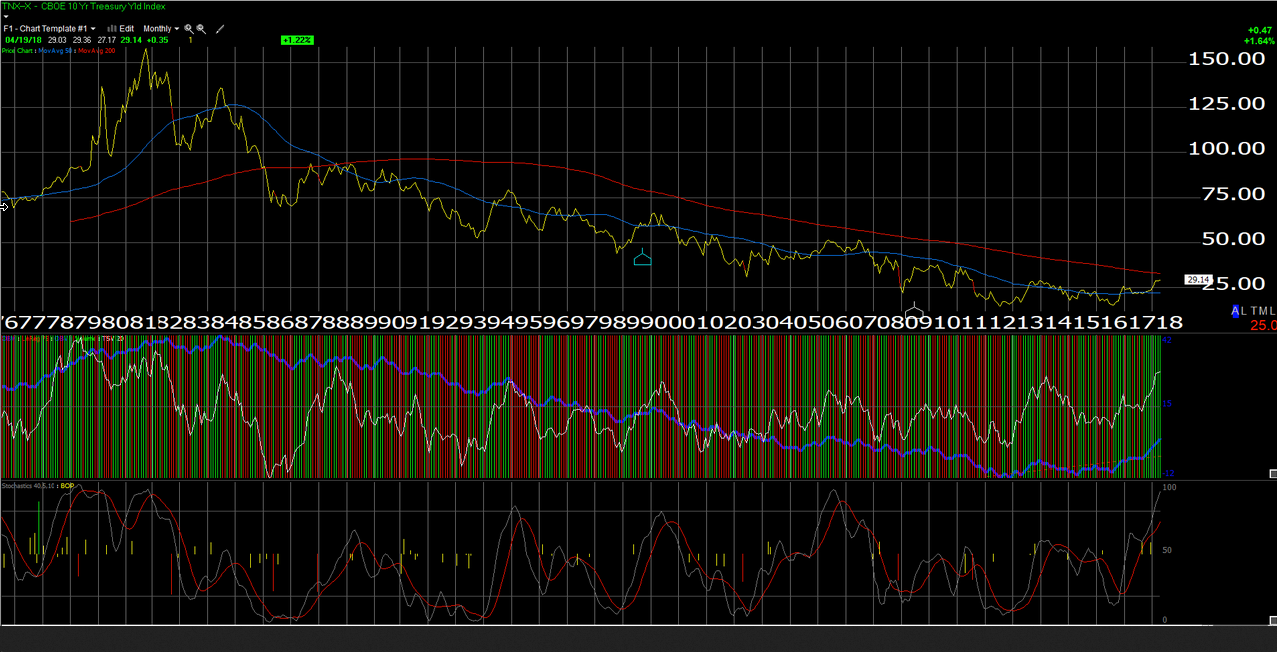The 10-year Treasury yield is two bps away from its 2018 high of 2.95% and through that level is 3-3.03%, which are the 2013-high ticks for the key Treasury security, and once we take out 3.03%, we are in uncharted territory and will see 10-year Treasury yields not seen since the mid 2000s.

The 10-year Treasury was still trading above 5% as of mid-August, 2007, about the time the Bear Stearn’s mortgage-related, hedge fund writedowns hit and the Street was just starting to get a whiff of what lay ahead in late, 2008. (The S&P 500 didn’t peak until October, 2007 so the Treasury and credit markets sniffed out the issues that would devastate the US economy in the coming 18 months.)
Brian Wesbury at First Trust doesn’t think the treasury yield curve will invert, a position with which I agree.
Westy’s rationale is that growth and inflation are picking are picking up, even though the Average Hourly Earnings metrics within the Nonfarm Payrolls reports have been benign the last few reports.
GDP is due April 27, before the market opens. Remember, the January 26 all-time-high for the S&P 500 came with the BEA’s (Bureau of Economic Analysis) release of Q4 ’17 GDP on January 26, which saw the PCE (personal consumption expenditure deflator) increase to 1.9%, sharply higher than the 1.6% for Q3 ’17.
As a dime-store economist, I've always been fortunate to have access to real economists like Jeff Miller of NewArc Capital in Chicago (Jeff has his PhD in econ from the University of Michigan and taught at the University of Wisconsin – Madison) and Brian Wesbury of First Trust and read their work studiously.
President Trump’s tax reform package should be stimulative to the US economy. A headline was seen on Twitter this morning that said the tax reform bill wasn’t effective, which is somewhat laughable in that the bill was signed just 120 days ago, and this weekend will be the 4-month anniversary of the bill signing on December 22nd, 2018.
The 1986 Omnibus Budget Act signed by President Reagan, which devastated commercial real estate by eliminating the “passive income loss” deduction that was prevalent throughout the 1980s took a couple of years to work through the pipeline, especially the US banking system, which has bought large, balloon-type, commercial mortgages through the 1980’s.
The point is the 1986 Tax Reform bill took years to be ultimately felt by the US economy and much of that could have been accelerated by the first Gulf War in late, 1990, early, 1991.
Also, the President’s tariff initiatives and somewhat hyperbolic trade rhetoric is also inflationary on top of the pretty substantial budget deficits that will be generated in the next few years.
The President has emphasized US industry and protecting long-suffering industries like steel and aluminum, which are a small percentage of the US industrial output and labor force. LizAnn Sonders, Schwab’s excellent Strategist has noted that the total US employment of potentially-protected industries by the China trade actions are far less than the US employment of the industries that are consumers of that product will be protected.
That could raise inflationary expectations (like auto prices, construction costs, etc) pretty quickly.
Put another way, the potential trade actions against China are anything but disinflationary.
In Short
Client’s bond allocations remain in cash, Schwab money-markets, a 5-10% position in the TBF (inverse Treasury ETF that is unlevered) one strategic income fund, which is JP Morgan’s Bill Eigen’s JSOSX fund. The TBF was one of the few fixed-income ETFs that had a positive return in Q1 ’18.
We had clients' bond portfolios positioned for higher interest rates far too early and we missed some years where high-grade bond funds performed quite well. We added some HYG after the collapse of crude oil in 2016, but we only held the high-yield position until mid to late 2016.
However the bond allocation, which is heavy cash and T-bills and the inverse Treasury, is looking quite attractive so far in 2018.
Remember, the Treasury market TLT hasn’t had a negative year since 2013.
Here are the key technical levels We're watching for recent TLT lows:
- Dec ’16: $116.80
- Mar ’17: $116.51
- Feb ’18: $116.51
Which stock should you buy in your very next trade?
With valuations skyrocketing in 2024, many investors are uneasy putting more money into stocks. Unsure where to invest next? Get access to our proven portfolios and discover high-potential opportunities.
In 2024 alone, ProPicks AI identified 2 stocks that surged over 150%, 4 additional stocks that leaped over 30%, and 3 more that climbed over 25%. That's an impressive track record.
With portfolios tailored for Dow stocks, S&P stocks, Tech stocks, and Mid Cap stocks, you can explore various wealth-building strategies.
